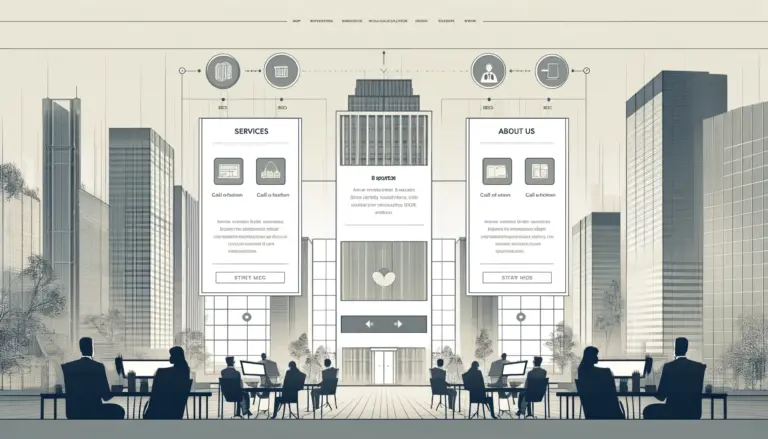In the rapidly changing B2B world, continuous development and adaptation is essential for success. Companies that continue to improve are better able to respond to market changes, customer needs and technological innovations. By continuously learning and innovating, companies can operate more efficiently, increase quality and remain competitive. This continuous process of improvement and adaptation helps companies stay flexible and perform better in a dynamic marketplace.

In this article, we discuss the nine defining traits that are critical to success as a B2B professional. These traits include strategic thinking, technological skills, creativity, innovative content strategy, data-driven decision-making, inquisitiveness, collaborative, strategic and communicative leadership, and a focus on diversity, equality and inclusion. By developing and optimizing these skills, B2B professionals can significantly increase their effectiveness and success.
Strategic Thinking Skills: What Is It and Why Is It Important?
Strategic thinking skills are the ability to develop long-term goals and plans while considering current market trends, competitors and internal company resources. This is essential for B2B professionals because it enables them to make informed decisions that not only respond to current challenges but also capitalize on future opportunities.
In the world of B2B marketing, strategic thinking means looking not only at direct sales numbers, but also at how your brand positions itself in the marketplace, how you build and maintain customer relationships, and how you can grow your business through innovation and adaptation. For example, a good strategic thinker can anticipate and proactively respond to changes in customer needs and market dynamics.
Benefits of Strategic Thinking Skills
Strategic thinking skills help B2B professionals make better decisions by having a broader perspective of the market and competition. By looking beyond the short-term, strategic thinkers can evaluate options based on their long-term impact and sustainability. This leads to decisions that are not just reactive, but proactive and forward-looking.
Long-term Vision
A long-term vision is crucial to the success of any B2B strategy. By thinking strategically, companies can plan beyond the next quarterly figures and focus on sustainable growth. This means investing in customer relationships, innovation and brand positioning. A long-term vision helps companies adapt to changing market conditions and remain continually relevant to their customers.
Tips for Developing Strategic Thinking Skills.
Continuous Learning and Continuing Education
One of the best ways to develop your strategic thinking skills is to continually learn and educate yourself. You can do this by taking courses, reading professional literature, and attending seminars and conferences. By staying abreast of the latest trends and developments in the B2B market, you can better anticipate changes and adjust your strategies accordingly.
Search for Mentors and Advice
Finding mentors who have experience in strategic thinking can be immensely valuable. Mentors can help you refine your thinking, offer insight into complex situations and guide you in making strategic decisions. You can also benefit from advice from experts and peers in your field by networking and sharing knowledge and experiences.
Practical Applications of Strategic Thinking in B2B Marketing
Strategic thinking is not just a theoretical concept; it has practical applications that can directly impact the success of B2B marketing campaigns. For example, by using marketing automation, companies can make their processes more efficient while creating personalized customer journeys that are more responsive to their customers’ needs. These types of strategic initiatives can lead to higher customer satisfaction and improved ROI.
In practice, strategic thinking also means better aligning your marketing and sales departments so they can work together toward common goals. This can be done through integrated CRM systems that provide seamless information exchange and a cohesive customer approach. By thinking strategically, B2B professionals can ensure that their business is not only successful today, but also ready for tomorrow’s challenges and opportunities.
By taking this approach, B2B professionals can develop and use their strategic thinking skills to take their businesses to new heights.
Technology Skills for B2B Professionals
What are Technological Skills and their Impact on B2B?
Technology skills refer to the ability to effectively use and apply modern technologies in business processes. For B2B professionals, these skills are crucial because they help optimize business operations, improve communication and increase efficiency. In the context of B2B marketing, technology skills can make the difference between achieving average results and outperforming competitors. Consider using Customer Relationship Management (CRM) systems, marketing automation tools, and data analytics to gain valuable insights and strengthen customer relationships.
The importance of technology skills in B2B marketing cannot be overemphasized. They enable professionals to manage complex marketing campaigns, create personalized customer approaches and make accurate predictions about customer behavior. This allows companies to better align their marketing strategies with customer needs and maximize their return on investment. In addition, using technology can help reduce inefficiencies and streamline processes, leading to increased productivity and lower operating costs.
Examples of Technology Use in Marketing Strategies
In practice, we see many B2B companies using technologies such as AI-powered CRM systems and marketing automation tools to improve their marketing strategies. One example is using AI to analyze customer data and create personalized marketing campaigns. This helps companies better understand their customers and reach them at the right time with the right message.
In addition, many B2B companies are using marketing automation tools to automate repetitive tasks and work more efficiently. This can range from automatically sending follow-up emails after a webinar to segmenting customers based on their behavior and personalizing content. By integrating these technologies into their marketing strategies, B2B companies can increase customer satisfaction and strengthen their competitive position.
Benefits of Technological Skills
Improving Efficiency with Technology
The use of technology can significantly improve the efficiency of business processes. By automating repetitive tasks, employees can focus on strategic initiatives that add more value to the business. For example, marketing automation tools can help manage large email campaigns without manual intervention, saving time and resources. In addition, data analytics tools can help provide quick and accurate insights, allowing businesses to make more informed decisions.
Another example is using project management software to better organize teams and manage deadlines. These tools provide a centralized place for communication and task management, which can lead to better collaboration and fewer misunderstandings. By using technology effectively, B2B companies can increase operational efficiency and improve overall performance.
Technology as a Competitive Advantage
Technology skills can also give companies a competitive advantage. In a rapidly changing market, the ability to quickly adopt and implement new technologies can make the difference between success and failure. Companies at the forefront of technological innovations can exploit new market opportunities more quickly and adapt better to changing customer needs.
For example, the use of AI and machine learning can help companies identify trends and patterns in customer behavior that would otherwise go unnoticed. This allows them to proactively capitalize on these trends and adjust their marketing strategies accordingly. Moreover, companies that use technology to improve their customer service, such as through chatbots and self-service portals, can achieve higher customer satisfaction and loyalty.
Tips for Improving Technological Skills.
Participating in Training Programs
One of the best ways to improve technology skills is by attending training programs. Many organizations offer courses that specifically focus on learning new software or technologies relevant to B2B marketing. These programs can range from online tutorials and webinars to intensive workshops and certification courses. By continuously learning and updating, B2B professionals can keep their technology knowledge up-to-date and be better prepared for future challenges.
In addition, companies can also invest in internal training programs to help their employees develop the necessary skills. This can be done through workshops, mentoring programs or internal knowledge-sharing sessions. By fostering a culture of continuous learning, companies can strengthen their technological competencies and improve their competitive position.
Gaining Practical Experience
In addition to formal training, hands-on experience is crucial for improving technology skills. This can be done by actively participating in projects where new technologies are deployed or by experimenting with different tools and software. For example, a marketer can get hands-on with a new marketing automation tool to discover how best to integrate it into existing processes.
Gaining hands-on experience not only helps to put theory into practice, but also to gain a deeper understanding of how technologies work and how they can be optimized for specific business goals. By combining hands-on experience with formal training, B2B professionals can take their technology skills to the next level and contribute more effectively to their organization’s success.
Creative Leading in B2B
Meaning of Creativity in B2B
Creativity is an essential trait for B2B professionals. It is not only about coming up with new ideas, but also finding innovative solutions to complex problems. Creativity plays a crucial role in marketing strategies by differentiating a brand from the competition. In the B2B market, where products and services are often technical and complex, a creative approach can help convey a message clearly and impactfully.
The importance of creativity in B2B is further highlighted by the need for unique and engaging content that captures and holds the attention of business customers. Through creative marketing campaigns, companies can stand out in a crowded marketplace and leave a lasting impression with potential customers. The use of visual elements, storytelling and interactive content are just a few ways creativity can be used to increase engagement and brand loyalty.
Successful Creative Campaigns
An example of a successful creative campaign in B2B marketing is the “Bridge to Possible” campaign from Cisco. This campaign used powerful storytelling and visual elements to show how their technology helps companies make connections and overcome challenges. By using a central theme that resonated with their target audience, Cisco was able to not only capture attention, but also make an emotional connection.
Another successful example is the interactive blog post from Shutterstock, presenting the latest trends in the graphic arts industry in a visually appealing way. By combining data and visual content, Shutterstock was able to showcase their expertise and provide valuable insights to their target audience. This approach not only increased traffic to their website, but also strengthened their position as a thought leader in the industry.
Benefits of Creative Leading
Differentiate with Creativity
Creativity helps companies stand out from the competition. In a market where many companies offer similar products and services, a unique and creative approach can make all the difference. By using creativity in marketing campaigns, companies can build a strong brand identity and communicate their message in a way that sticks with the target audience. This can range from using innovative visual elements to telling compelling stories that reflect the company’s core values and mission.
A unique brand identity makes it easier for customers to recognize and remember a company. This can lead to increased brand loyalty and stronger customer loyalty. Moreover, a distinctive brand can help companies justify higher prices, as customers are willing to pay more for products and services from a brand they perceive as unique and valuable.
Higher Engagement of Customers
Creative marketing strategies can also lead to increased customer engagement. By using engaging and interactive content, companies can capture the attention of their target audience and encourage them to actively participate in marketing campaigns. This can be done, for example, by hosting online events, offering interactive webinars or creating gamified content that enriches the user experience.
Higher customer engagement often leads to better customer satisfaction and loyalty. When customers feel engaged with a brand, they are more likely to make repeat purchases and spread positive word of mouth. This, in turn, can lead to a larger customer base and increased sales. By incorporating creativity into marketing strategies, companies can strengthen relationships with their customers and improve their competitiveness.
Tips for Creative Leading
Regular Brainstorming
An effective way to foster creativity is to organize regular brainstorming sessions. During these sessions, team members can freely share ideas and inspire each other. It is important to create an open and supportive environment where everyone feels comfortable expressing their ideas. Brainstorming sessions can help discover new perspectives and find innovative solutions to existing challenges.
In addition, it can be helpful to bring diverse teams together during brainstorming sessions. Having people with different backgrounds and areas of expertise working together can produce unique and creative ideas. Combining different perspectives can lead to surprising and effective marketing strategies that might otherwise be overlooked.
Following Creative Workshops
Attending creative workshops is another effective way to improve the creative skills of B2B professionals. These workshops provide an opportunity to learn new techniques and approaches and get inspiration from experts in the field. Workshops can range from courses in graphic design and storytelling to training in innovative marketing strategies and content creation.
Creative workshops not only provide valuable learning opportunities, but can also be a source of new ideas and inspiration. By participating in workshops, B2B professionals can expand their knowledge and skills and become better able to come up with creative solutions to their marketing challenges. In addition, workshops can provide networking opportunities, allowing professionals to connect with like-minded individuals and potential collaboration partners.
By regularly brainstorming and participating in creative workshops, B2B professionals can boost their creativity and develop more effective marketing strategies. These approaches help them stand out from the competition and make a lasting impression on their target audience.
Innovative Content Strategy for B2B
What Does Innovative Content Strategy Mean?
An innovative content strategy is a plan that helps companies creatively and effectively reach and engage their target audience. It goes beyond posting standard blogs and social media posts. This strategy includes using new technologies, trends and unique content forms to capture and hold attention. Innovative content strategy is all about finding original ways to share valuable information that helps and engages the target audience.
By implementing an innovative content strategy, companies can stand out in a competitive marketplace. This means not only creating informative content, but also telling inspiring and engaging stories that capture the interest of their audience. A well-thought-out content strategy helps companies build their brand, gain trust and maintain long-term relationships with their customers.
Example of Innovative Content Strategies
A successful example of an innovative content strategy is the Whiteboard Friday series from Moz. Every Friday, Moz publishes a video explaining complex SEO concepts in a simple way using a whiteboard. This has not only helped position Moz as a thought leader in the SEO industry, but has also built a loyal follower base that returns each week for new content.
Benefits of Innovative Content Strategy
Stronger Connection with the Public
An innovative content strategy can help build stronger relationships with audiences. By using engaging and interactive forms of content, companies can more actively engage their audience with their brand. This can range from interactive quizzes and polls to live webinars and podcasts. When audiences feel engaged, they are more likely to remain loyal and spread positive word of mouth for the brand.
By consistently providing valuable and interesting content, companies can create a sense of community and connection. This can be further enhanced by using storytelling and sharing customer stories that resonate with the audience’s experiences and challenges. A strong connection with the audience leads to higher customer satisfaction and brand loyalty, which ultimately contributes to business growth and success.
Improved Performance of Content
Innovative content strategies can also lead to improved content performance. By using data analysis and trend research, companies can better understand what appeals to their audience and what content performs best. This allows them to continually optimize and adapt their content to the changing needs and interests of their target audience.
The use of new technologies, such as AI and machine learning, can also help personalize content and make it more relevant to individual users. Personalized content drives higher engagement and conversion rates because it better matches users’ specific needs and preferences. In addition, innovative content forms, such as interactive infographics and videos, can be shared more on social media, leading to greater reach and exposure for the brand.
Tips for Innovative Content Strategy
Analyzing Trends
An important step in developing an innovative content strategy is analyzing trends. By staying abreast of the latest industry trends and developments, companies can keep their content relevant and up-to-date. This can be done by conducting regular market research, attending industry events and monitoring competitors and influencers in the market.
Analyzing trends helps companies anticipate market changes and create content that is responsive to the current needs and interests of their target audience. This can range from responding to seasonal trends to using emerging technologies and platforms. By constantly learning and adapting to the changing market, companies can keep their content strategy innovative and effective.
Collecting Feedback from the Public
Gathering audience feedback is essential to improving and refining a content strategy. By listening to what audiences have to say, companies can gain valuable insights into what works and doesn’t work in their content. This can be done through surveys, polls, social media interactions and monitoring reactions and comments on content.
Audience feedback helps companies better understand what their audience values and needs. These insights can be used to adjust and optimize the content strategy to better match the audience’s expectations and desires. By actively listening and responding to feedback, companies can develop a more customer-centric and successful content strategy.
Data-driven Decision Making in B2B
The Importance of Data in Decision Making
Data-driven decision-making means making decisions based on analyzed data rather than intuition or gut feeling. This helps companies make informed choices based on factual information. In the B2B sector, this is especially important because decisions are often complex and can have major consequences. By using data analytics, companies can identify trends and patterns that might otherwise be overlooked.
A data-driven approach begins by collecting relevant data from various sources, such as customer data, sales figures and website analytics. This data is then analyzed using tools such as Power BI, which helps provide insights that support decision-making. Centralizing this data in a clear dashboard ensures that all stakeholders have access to the same information, which promotes collaboration and efficiency within the organization.
How Data Can Drive Decision Making
Data can drive decision-making in several ways. First, data analysis allows companies to identify inefficiencies in their processes and optimize them. This leads to cost savings and improved operational efficiency. In addition, companies can better respond to changes in the market by using real-time data to identify trends and opportunities. This allows them to react faster and adapt to new circumstances.
In addition, data-driven decision-making provides a competitive advantage. Companies that use data to inform their decisions can be more flexible and responsive to their customers’ needs. This leads to better customer satisfaction and loyalty. Moreover, it helps predict future trends, allowing companies to proactively plan and make strategic decisions that strengthen their position in the market.
Benefits of Data-Driven Decision Making
Accuracy in Strategy and Execution
One of the greatest benefits of data-driven decision-making is the increased accuracy in both strategy and execution. When decisions are made based on comprehensive data analysis, mistakes are less likely to be made. This is because decisions are supported by concrete facts and figures rather than assumptions. This leads to better strategic plans and more effective execution of those plans.
By using data to inform decisions, companies can also better measure and evaluate how successful their strategies are. This allows for continuous adjustment and optimization based on the latest data. This allows companies to stay relevant and continue to improve their performance.
Predictive Insights for the Future
Data-driven decision-making also provides predictive insights that help companies prepare for the future. By analyzing historical data, companies can identify patterns and trends that help them predict future events. This is especially useful in the B2B market where long sales cycles and complex decision-making processes are common.
With predictive insights, companies can anticipate changes in the market and adjust their strategies accordingly. This can range from adjusting inventory levels based on expected demand to developing new products or services that respond to emerging trends. This proactive approach helps companies stay competitive and be better prepared for future challenges.
Tips for Data-Driven Decision Making
Developing Skills in Data Analysis
Developing skills in data analysis is essential for effective data-driven decision-making. This means training employees to interpret and analyze data. Skills such as using data analysis tools, understanding statistical methods and being able to visualize data are crucial. Companies can invest in training and workshops to help their teams develop these skills.
In addition, it is important to create a culture in which data is central to decision-making. This means integrating data analytics into daily business processes and encouraging employees to use data when making decisions. By fostering a data culture, companies can ensure that data-driven decision-making becomes an integral part of their operational strategy.
Use of Data Analysis Tools
Using data analysis tools is another important tip for data-driven decision-making. Tools such as Power BI, Tableau and Google Analytics can help companies collect, organize and analyze large amounts of data. These tools offer advanced data visualization features that allow complex data to be presented in an understandable way. This allows companies to gain faster and more effective insights that support their decision-making.
Choosing the right data analysis tools depends on the company’s specific needs and goals. It is important to choose tools that are user-friendly and integrate well with existing systems. In addition, companies should ensure that they provide the right training and support for their employees to use these tools effectively. By using the right tools, companies can optimize their data analysis processes and make better decisions based on accurate and up-to-date data.
Continuous Learning for B2B Professionals
Why Continuing Education is Important
Continuing education is essential for professionals in the B2B industry because the marketplace and technologies are constantly changing. Continuous learning keeps you abreast of the latest trends and developments in your field. This helps you stay relevant and competitive. Moreover, continuous education allows you to acquire new skills and improve existing ones, which is crucial for your professional growth and success.
In a world where innovation is rapid, the ability to learn and adapt is a key factor for success. Companies expect their employees to be proactive in keeping up with new knowledge and skills. This can range from taking online courses to attending seminars and workshops. By continually developing yourself, you will be better prepared for the challenges and opportunities that arise in your career.
Examples of Continuous Learning in Practice
Continuous learning can be applied to practice in a variety of ways. One common method is taking online courses and training. Platforms such as Coursera, Udemy and LinkedIn Learning offer a wide range of courses that you can take at your own pace. These courses range from technical skills such as data analysis and programming to soft skills such as communication and leadership.
In addition, it is important to network with other professionals in your field. You can do this by joining professional organizations, attending conferences and workshops, and actively participating in online forums and groups. By networking, you can not only gain new knowledge and insights, but also make valuable contacts that can help you in your professional career.
Benefits of Continuous Learning
Continuous Improvement of Skills
One of the main benefits of continuous learning is the ability to continuously improve your skills. By regularly acquiring new knowledge and updating your skills, you will remain relevant and valuable to your employer. This can help you earn promotions, take on new responsibilities and advance your career. In addition, improving your skills can boost your self-confidence and increase your motivation.
Investing in your own development also shows that you are dedicated to your field and willing to learn and grow. This can set you apart from others and make you more attractive to potential employers. So continuously improving skills is not only good for your current job, but also for your future career.
Adaptability in a Changing Marketplace
Continuous learning also helps you adapt to changes in the marketplace. In the dynamic B2B sector, market conditions, customer needs and technologies can change rapidly. Continually educating yourself helps you respond to these changes and adapt your strategies and practices. This adaptability is crucial to remain successful in an ever-changing environment.
In addition, it allows you to be proactive rather than reactive. Instead of waiting until you are forced to learn new skills, you can plan ahead and prepare yourself for future changes. This gives you a competitive advantage and helps you perform better in your role.
Tips for Continuous Learning
Taking Online Courses
An effective way to continually learn is to take online courses. There are numerous platforms that offer high-quality courses in various fields. These courses are often flexible and can be taken at a time that is convenient for you. This makes it easy to integrate learning into your busy schedule. In addition, many online courses offer certificates that you can add to your professional profile.
It is important to choose courses that are relevant to your field and career goals. Look for courses that are taught by reputable instructors and have good reviews from other students. By taking new courses regularly, you can keep your knowledge up-to-date and continue to improve your skills.
Networking with Professionals
Networking with other professionals is another valuable way to continuously learn. By participating in professional networking, you can connect with other experts in your field and learn from their experiences and insights. You can do this by joining professional associations, attending conferences and events, and actively participating in online communities and forums.
Networking offers not only the opportunity to gain new knowledge, but also to build valuable relationships that can help you in your career. Regular networking keeps you abreast of the latest trends and developments in your field and allows you to position yourself as an active and engaged professional.
Collaborative orientation as a B2B professional
Importance of Teamwork and Collaboration in B2B
Being collaborative is crucial in the B2B sector, where teams are often made up of professionals with different areas of expertise. By working together effectively, these teams can leverage each other’s strengths, leading to better results. Collaboration ensures that everyone contributes from their own expertise, significantly improving the quality of the final product or service. Moreover, teamwork helps share knowledge and develop innovative solutions.
In practice, this means that teams should meet regularly and be open to each other’s ideas and feedback. This can be done, for example, by organizing weekly meetings in which progress is discussed and any obstacles are addressed together. Fostering a culture of collaboration allows companies to work faster and more efficiently, which is crucial in a competitive marketplace.
Examples of Successful Collaborations
There are numerous examples of successful collaborations in the B2B sector. A good example is the development of a new website, where a team of graphic designers, copywriters, developers and marketing professionals collaborates. Each member of the team brings their own expertise, resulting in a website that is not only functional, but also visually appealing and easily findable in search engines.
Another example is the collaboration between different departments within a company to launch a new product. The marketing department may conduct market research to understand customer needs, while the product development department works on the design and production of the new product. Through regular consultation and collaboration, these departments can coordinate their efforts and ensure that the product is successfully brought to market.
Benefits of Collaborative Focus
Synergy Within Teams
A key benefit of being collaborative is the synergy created within teams. When team members work together effectively, they can leverage each other’s strengths and compensate for weaknesses. This leads to higher productivity and better results. Synergy within teams also ensures that problems are solved more quickly because multiple people can bring their perspective and expertise to the table.
In addition, synergy promotes a positive work environment in which team members support and motivate each other. This not only increases employee satisfaction and engagement, but also contributes to the success of the project or organization. By working together, teams can achieve more than the sum of their individual contributions.
Achieving Shared Goals
Collaboration enables teams to achieve common goals that would otherwise be difficult to achieve. By setting clear goals and working together to implement them, teams can work more efficiently and effectively. Shared goals ensure that everyone is in the same boat and working toward the same end results, strengthening team cohesion and cooperation.
Achieving shared goals requires open communication and a clear division of labor. By regularly discussing progress and giving each other feedback, teams can coordinate their efforts and overcome any obstacles. This leads not only to better results, but also to a greater sense of accomplishment and satisfaction among team members.
Tips for Collaborative Focus
Participation in Team Building Activities
Team building activities are an excellent way to strengthen cooperation and cohesion within a team. These activities can range from informal outings such as joint lunches or sporting events to more structured workshops and training sessions. By participating in team building activities, team members get to know each other better and develop trust and respect for each other.
Team-building activities also help identify the strengths and weaknesses of team members, which can help improve task distribution and cooperation. In addition, these activities promote a positive work atmosphere and increase employee motivation and engagement. Regular team building activities can have a significant impact on a team’s effectiveness and success.
Promoting Open Communication
Open communication is essential for effective collaboration. Fostering an open communication style within the team ensures that everyone feels heard and valued. This can be achieved by holding regular team meetings in which all team members have the opportunity to express their ideas and concerns. It is also important to create a culture of feedback, where team members can give and receive constructive feedback without fear of negative consequences.
In addition, digital collaboration tools such as Slack, Microsoft Teams or Trello help improve communication and coordination within the team. These tools make it possible to share information, manage tasks and track project progress. By promoting open communication and using the right tools, teams can work together more effectively and achieve better results.
Strategic and Communicative Leadership
Importance of Leadership Qualities in B2B
Strategic and communicative leadership is essential for success in the B2B industry. This type of leadership allows leaders to set clear goals and develop a vision that sets the direction of the company. Strategic leadership is about making long-term plans and decisions that help the company grow and stay competitive. Communicative leadership, on the other hand, ensures that these plans are effectively conveyed to the team so that everyone is on the same page.
In practice, this means that leaders must communicate regularly with their team members, give and receive feedback, and be open to new ideas. A leader who is strategically and communicatively strong can inspire and motivate their team to collectively achieve business goals. This leads to a more engaged and motivated team, which ultimately results in better business results.
Examples of Effective Leadership
Effective leadership in the B2B sector can be expressed in a variety of ways. One example is a leader who acts quickly and thoughtfully during a crisis. Through clear communication and strategic decisions, the leader can guide the team through difficult times and ensure that the company emerges stronger from the crisis. Another example is a leader who invests in the development of his team members through training and workshops. This helps not only the personal growth of the employees, but also the growth of the company as a whole.
A leader who hosts regular feedback sessions and promotes open communication creates an environment where team members feel heard and valued. This leads to increased employee satisfaction and loyalty, which is essential to the success of any business. By creating a culture of openness and trust, a leader can ensure that the team works together effectively and efficiently toward business goals.
Benefits of Strategic and Communicative Leadership
Clear Direction for Teams
One of the key benefits of strategic and communicative leadership is that it provides clear direction for teams. Leaders who are able to communicate a clear vision and strategy help their team members understand what is expected of them and what goals they need to achieve. This reduces confusion and ensures everyone is on the same page, which increases efficiency and productivity.
In addition, clear direction helps prioritize and make decisions. When team members know what the main goals are, they can focus their efforts on the tasks that contribute most to the company’s success. This leads to better results and a more organized work environment, where everyone knows what needs to be done and why.
Increased Motivation and Engagement
Strategic and communicative leadership also leads to increased motivation and engagement among team members. When leaders clearly communicate their vision and strategy, team members feel more committed to the company’s success. They understand how their work contributes to the larger goals and are therefore more motivated to put their best foot forward.
In addition, communicative leadership makes team members feel valued and heard. Leaders who are open to feedback and communicate regularly with their team create a positive work environment where everyone feels included. This not only increases motivation, but also employee loyalty, which is crucial to talent retention and the company’s long-term success.
Tips for Strategic and Communicative Leadership
Following Leadership Training
An effective way to improve strategic and communicative leadership is by attending leadership training programs. These trainings provide leaders with the tools and techniques needed to develop their strategic and communication skills. They learn how to create a clear vision, how to effectively motivate their team and how to foster open communication.
Leadership training can also help develop personal skills such as emotional intelligence, problem-solving and decision-making skills. By continually investing in their own development, leaders can be more responsive to the needs of their team and the challenges of the rapidly changing B2B marketplace.
Creating a Culture of Feedback
Another important tip for strategic and communicative leadership is to create a culture of feedback. Feedback is essential for growth and improvement, both for individual team members and the team as a whole. Leaders must create an environment where giving and receiving feedback is the norm. This can be done by hosting regular feedback sessions and encouraging team members to share their thoughts and ideas.
It is also important that leaders themselves are open to feedback and demonstrate a willingness to learn and grow. This creates a culture of trust and openness, where everyone feels free to express their opinions and contribute to the team’s improvement. By making feedback an integral part of the company culture, leaders can ensure that their team continues to grow and improve continuously.
Focused on Diversity, Equality and Inclusion
Definition and Importance of DEI in the B2B environment
Diversity, equity and inclusion (DEI). are essential elements in the modern B2B environment. Diversity refers to the presence of differences within a workplace, such as gender, ethnicity, age and background. Equality means that everyone is treated fairly and given equal opportunities, regardless of their background. Inclusion is about creating an environment where everyone feels welcome and valued. DEI is crucial not only because it is morally right, but also because it promotes business performance and innovation.
In a diverse work environment, different perspectives and experiences can contribute to more creative solutions and better decision-making. Equal treatment and opportunities ensure that all employees can reach their full potential. Inclusion makes everyone feel included in the company, leading to higher employee satisfaction and loyalty. As a result, companies can not only attract and retain talent, but also strengthen their competitive position.
Success stories from DEI initiatives
There are numerous examples of companies that have achieved success by investing in DEI initiatives. One well-known example is Unilever, where employees can exchange their national holidays for days they consider important, contributing to an inclusive work culture. This policy has led to increased employee satisfaction and a sense of appreciation among diverse groups within the company.
Another success story comes from Aegon, which was the first Dutch company in the CLA included that men and women should be paid equally. This initiative increased equality in the workplace and improved Aegon’s reputation as an employer. By undertaking such initiatives, companies can demonstrate their commitment to DEI, which not only improves workplace culture but also produces positive business results.
Benefits of Diversity, Equality and Inclusion
Innovation through Diverse Perspectives
One of the main benefits of diversity in the workplace is the increase in innovation. When teams consist of people with different backgrounds and perspectives, new ideas and creative solutions emerge. Diversity encourages employees to think outside their usual boxes and encourages an innovative culture within the company. This can lead to better products and services that better meet the needs of a diverse customer base.
In addition, an inclusive workplace helps foster collaboration and teamwork. When employees feel valued and respected, they are more likely to share their ideas and collaborate on projects. This increases team productivity and efficiency, which ultimately contributes to the company’s success.
Employee Satisfaction and Retention
Diversity, equality and inclusion also have a positive impact on employee satisfaction and retention. Employees who feel valued and understood are generally happier and more satisfied with their work. This leads to higher loyalty and lower turnover, which is important for retaining talent within the company.
In addition, an inclusive workplace contributes to a positive work environment, where employees feel safe and supported. This not only promotes employee well-being, but also their engagement and commitment. Companies that invest in DEI can count on a more motivated and productive team, which ultimately leads to better business results.
Tips for Diversity, Equality and Inclusion.
Inclusive Policy Development
To create an inclusive workplace, it is important to develop inclusive policies. This starts with adapting recruitment texts to attract a wider range of candidates. Use language that appeals to everyone and avoid terms that may exclude certain groups. Ensure that the recruitment process is free of bias and that selection criteria are fair and objective.
In addition, it is important to periodically monitor and address pay disparities. Ensure that all employees are rewarded equally for equal work, regardless of their background. This helps reduce dissatisfaction and inequality in the workplace and promotes a sense of fairness among employees.
Programs for Awareness and Education.
Awareness and education are crucial to promoting diversity, equality and inclusion in the workplace. Organize regular trainings and workshops to make employees aware of their unconscious biases and teach them how to act more inclusively. These programs can help create a culture of respect and openness where everyone feels welcome.
It is also important to collect and use feedback from employees to improve workplace culture. Regularly ask for their experiences and opinions on diversity and inclusion, and take action based on their feedback. This shows that the company is committed to continuous improvement and that the voices of employees are heard and valued.
Conclusion
In today’s B2B marketplace, there are nine traits that are essential for success as a B2B professional. These traits, identified by a survey of LinkedIn, are crucial to prepare you for future leadership and to perform effectively in an ever-changing business environment. Key attributes include strategic thinking, customer focus, adaptability, and data analysis skills.
Strategic thinking helps you set and achieve long-term goals, while customer focus ensures that you put your customers’ needs at the center of everything you do. Adaptability allows you to respond flexibly to changes in the marketplace, and data analysis skills help you make fact-based decisions that move your business forward. Together, these traits enable B2B professionals to stand out and be successful in their field.
In addition, the ability to effectively communicate and collaborate with diverse teams is key. Fostering an inclusive work culture allows B2B professionals to leverage different perspectives and develop innovative solutions. This contributes not only to a positive workplace, but also to better business results and customer satisfaction.
Future-oriented Leadership and Skills.
For future success, it is important to continuously invest in personal and professional development. Stay abreast of the latest trends and technological developments in the B2B market. Use data and analytics to understand customer behavior and market trends, and adjust your strategies accordingly. By being proactive and always striving to improve, you can prepare for future challenges and opportunities.
In addition, it is crucial to build and maintain a network. Collaborating with other professionals in the B2B sector can lead to valuable insights and new business opportunities. By participating in relevant seminars, workshops and networking events, you can increase your knowledge and expand your professional contacts.
Finally, don’t be afraid to take risks and make mistakes. Innovation and growth often come from daring to experiment and learn from failure. By maintaining a willingness to learn and an open attitude, you can continue to develop yourself and strengthen your position as a successful B2B professional.
LinkedIN Infographic







